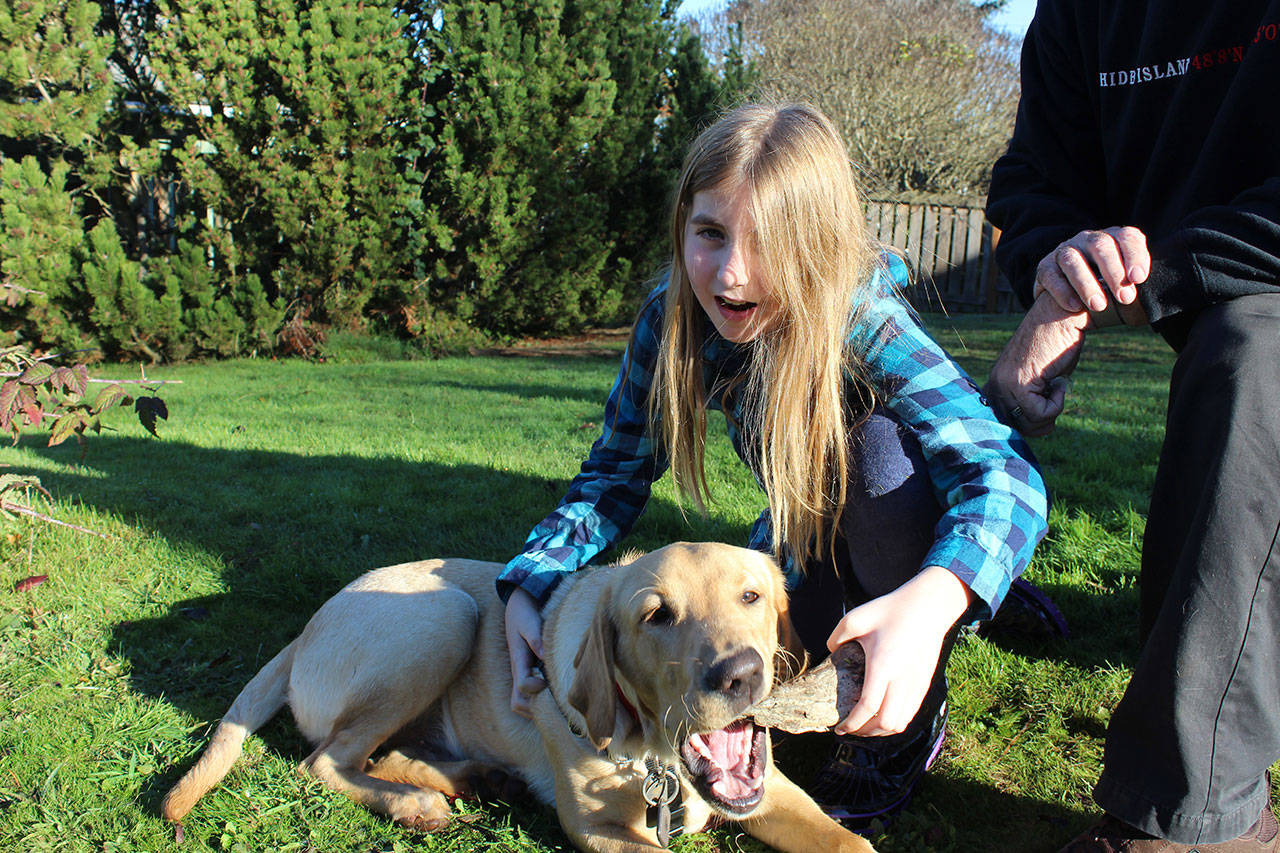A yellow pup named Scout recently discovered a mighty old and odorous bone in his backyard near downtown Langley.
What Scout’s dad, owner Kirk Lacewell, thought was a rock in his puppy’s mouth turned out to be a small part of a fossilized tooth from a woolly mammoth.
University of Washington paleontologists estimate the tooth to be about 13,000 years old, when the furry tusked creatures roamed Whidbey Island.
“Quite a few mammoth teeth and some bones have been found on Whidbey, which is largely composed of Ice Age sediments,” said Elizabeth A. Nesbitt, curator of paleontology at UW’s Burke Museum.
Scout, an energetic and extra-friendly yellow Labrador retriever, was a mere 5-month-old baby old when he sunk his teeth into the tidbit of old tooth — a whole tooth would be twice the size of Scout’s head.
Apparently, it’s a really, really smelly and tasty tooth. Because when Lacewell recently took out the tooth from its safe place in the closet, Scout lunged for it.
“It does smell, I can smell something musty on it,” declared Lacewell’s granddaughter, Piper Pontius.
Her grandfather then described the discovery.
“About two months ago I saw him carrying what looked like a rock around the yard and didn’t give it any thought,” Lacewell said.
“When I saw him carrying it the next day I became interested, as he has never had any interest in rocks. I took it from him and at first I thought that it was a piece of petrified wood, something I collect.
“I washed it and decided that it wasn’t petrified wood. It took a couple of weeks to really dry out, but as it did it started looking like bone to me.”
Lacewell measured it and sent off detailed photos to the Burke Museum.
Nesbitt consulted with two colleagues who concurred the pup had struck prehistoric pay dirt, so to speak.
Nesbitt replied to Lacewell that it looked like a worn, fossilized tooth of a woolly mammoth.
The lumbering veggie-eating predecessor of the Asian elephant roamed the Earth for tens of thousands of years before becoming extinct.
With the scientific name of Mammuthus primigenius, the woolly mammoth lived in the late Pleistocene period, which started about 1.8 million years ago and ended just 10,000 years ago with the last Ice Age.
Woolly mammoths lived in the cold of the tundra. Columbian mammoths, which were much larger, preferred the more temperate regions of southern and central North America.
All mammoths stem from an ancestral species, the African mammoth, that lived in northern Africa and disappeared about 3 or 4 million years ago.
Columbian mammoths, Mammuthus columbi, are the most common species of mammoth fossil found in this part of Washington state, according to the Burke Museum.
An Island County Historical Museum permanent exhibit includes the story of mammoths and mammoth hunters.
Many of the bones on display were collected by amateur paleontologist, Dale Conklin, Whidbey’s “mammoth hunter.”
“Mammoths and mastodons both roamed throughout the area that was south of the ice sheets during the Ice Age,” Nesbitt said in an interview.
“They had to have a lot to eat so had to be in the area that was without ice.”
Many believe that mammoths disappeared because of a change in climate, disease, hunting by humans, or perhaps some combination of these, according to the University of California Paleontology Museum.
Lacewell says he plans to keep his dog’s discovery in a display shadow box as it’s not rare enough to be a museum piece.
The experts, though, were still impressed.
“Nice find,” enthused Nesbitt. “Good dog!”


